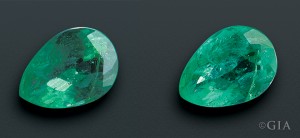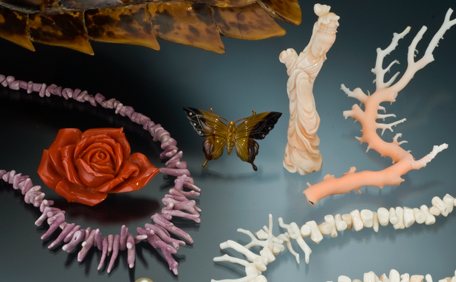If you love your jewelry, you’ll want it to always look as stunning as it did when it was new.
Ultrasonic cleaners can restore the beauty of your bejeweled treasures. These machines generate high-frequency sound waves that travel through water or a cleaning solution creating heat and pressure. Ultrasonic machines can effectively clean jewelry by dislodging dirt and debris from behind gems and other hard-to-reach places.

Before (L) and after (R): This emerald was cleaned in an ultrasonic cleaner, which dramatically changed its appearance.
You can buy a professional ultrasonic cleaner for $150 or less. But ultrasonic cleaners come with a word of caution: not all gems and jewelry can be safely cleaned in them. So resist the urge to spring clean your treasures without doing a little research first.
Here’s a list of “dos and don’ts” to consider:
- Don’t use an ultrasonic to clean gemstones that have surface reaching breaks that have been filled. Diamonds, for example, can be fracture filled with a lead glass-like substance. Emeralds’ fractures are commonly filled with oil, resin or wax. The goal of these treatments is to improve apparent clarity. However, these types of treatment are not permanent and can be damaged or removed. Other gemstones may be similarly treated.

When a fracture filled diamond is left in an ultrasonic cleaner too long, the filling can be damaged – which is what happened to this 0.34 ct treated diamond. Photo by Shane F. McClure/GIA
- Don’t use an ultrasonic to clean organic gem materials. These are porous materials and should never be cleaned using an ultrasonic machine because they can be damaged by the heat of an ultrasonic cleaner and the chemicals in most cleaning solutions. Pearls,coral, tortoise shell, ivory, shell cameos, jet, and amber should not be put in an ultrasonic cleaner.

Tortoise shell (upper left), orange coral flower, lavender coral necklace, three cultured pearls, tortoise shell butterfly pin, angel skin coral carving, pink coral branch, a white coral necklace. Photo by Robert Weldon/GIA.
- Don’t use an ultrasonic machine if the gems have been impregnated or coated with oil, plastic or wax. These treatments are often used on gems such as emerald, lapis lazuli, malachite, and opal.
- Avoid ultrasonic cleaners if the gem has been treated by heat, a method used to enhance color.While transparent ruby and sapphire require caution, star ruby and star sapphire should not be cleaned in an ultrasonic machine.
- There are many gems that are susceptible to heat and temperature changes and should not be cleaned in an ultrasonic regardless of whether they are treated or untreated. Some of these gems include tanzanite , feldspar (sunstone and moonstone), fluorite, iolite, kunzite, lapis lazuli, malachite, opal, topaz, turquoise, zircon, and others.
- Use gentle cleaning solutions that are specially formulated for delicate gems or just warm, soapy water to clean these gems and metals that are oxidized or antique. Standard cleaning solutions can damage delicate gem materials and surface finishes.
- Check to make sure the gemstones in your piece are securely set in their mountings both before and after cleaning. The vibration generated by an ultrasonic cleaner can sometimes shake gems loose or cause damage if gems are set with their girdles touching.

The handiwork in this stunning cameo of the Three Graces is so artful that it is worthy of gracing a museum. No ultrasonic cleaner for this piece! Photo by Robert Weldon/GIA, courtesy of MMH Collection.
All these warnings may make you wonder why you would use an ultrasonic cleaner in the first place. The key is carefully following the manufacturers’ instructions, and knowing if your gem has been treated. This is where a GIA report comes in – it contains important information about your gem and any detectable treatments.
If you’re uncertain about the durability of your gem, avoid using ultrasonic cleaners to be safe – and use the GIA Retailer Look Up to find a jeweler in your area who can give your jewelry a professional-quality cleaning.
Custom Field: Array
